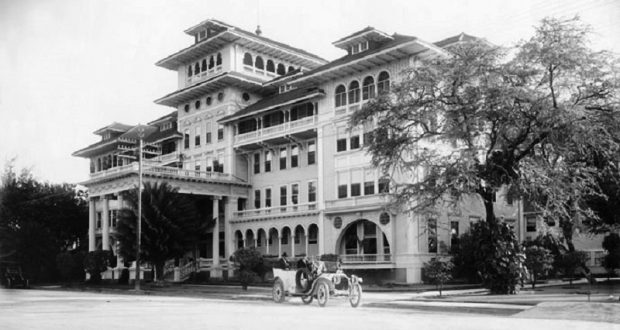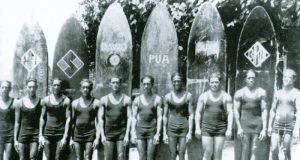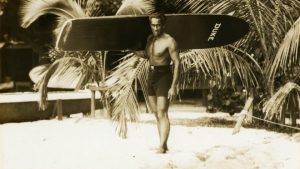By Sal Maccarone
Through the ages mankind has always had a fascination with the reconfiguring of landscape. For example, what once was the Isthmus of Panama is now the Panama Canal, what once was a desert in Nevada is now Las Vegas, and what once was a swampland in Hawaii is now the very famous Waikiki Beach. Waikiki, in Honolulu, is a narrow beach that has been modified extensively through the years. Before 1880 it was a just a natural island of sand bordered on all sides by fish ponds, duck coves, mudflats, and wetlands. At that time the adjacent reef made it a favorite retreat and surfing spot for Hawaiian royalty. These early surfers were also the inventors of the famous sixteen foot “longboard,” which weighed in at about 110 pounds and was made of Koa, a rare island wood.
Affectionately referred to as “The First Lady of Waikiki,” the Moana Hotel is the original flagship of Hawaiian tourism. The word Moana loosely translates to mean “the open ocean” and the open ocean is exactly what brought the steamships and passengers to the hotel. It was 1896 when the English businessman, Walter Peacock, first had an idea of developing a hotel that would make Waikiki into an international destination. Many of his friends and peers thought that he had misplaced his mind. But, he was armed with a beautiful design by Minnesota architect, Oliver Traphagen, and he was determined to build his first class hotel. Of course, a canal had to be dug first in order to drain the swampy site. On March 11, 1901, amidst much fanfare, the hotel opened to a group of mainland Shriners that each paid the outrageous sum of $1.50 a night.
Designed in the old colonial style of architecture, Peacock’s 75 room hotel was five stories high, with two more floors being added in 1918. It had huge Ionic columns that support the Grand Porte Cochere entrance that opens directly onto Kalakaua Avenue. Once inside the intricately detailed main reception area, you could turn left into the library or right into the saloon and billiard parlor. There was an elevator, still in use, and innovative electric lighting which was all powered by the hotel’s own generator. Each of the rooms on the top three floors were equipped with a private bathroom and telephone. There was also a 150-foot high rooftop observatory with a 360 degree view.
Through the years this famous property has had its fair share of mysteries and hauntings. In 1905, there was the unsolved murder that involved the wife of then California Governor Leland Stanford. When Jane Stanford was poisoned in her room, she let it be known that “she would not leave this earth peacefully.” Legend now has it that she was seen in the hotel many times by staff and guests for more than twenty years after her death. In 1938, her famous room was removed during a major renovation, and she has not been seen since.
Nowadays, it is the manifestations of the legendary Olympian Duke Kahanamoku (1890 – 1968) that have been causing a stir. Kahanamoku popularized the sport of surfing during the 1920s and the private beach directly behind the hotel is where he honed his skills. He and his famous group, “The Waikiki Beach Boys,” became a worldwide sensation and were a tourist attraction in themselves.
To this day, hazy images of the Duke have been known to appear on Waikiki beach, and in the water riding the waves.
Here is a short video clip about the Moana Hotel:
Sal Maccarone
salmaccarone@gmail.com
salmaccarone.com







